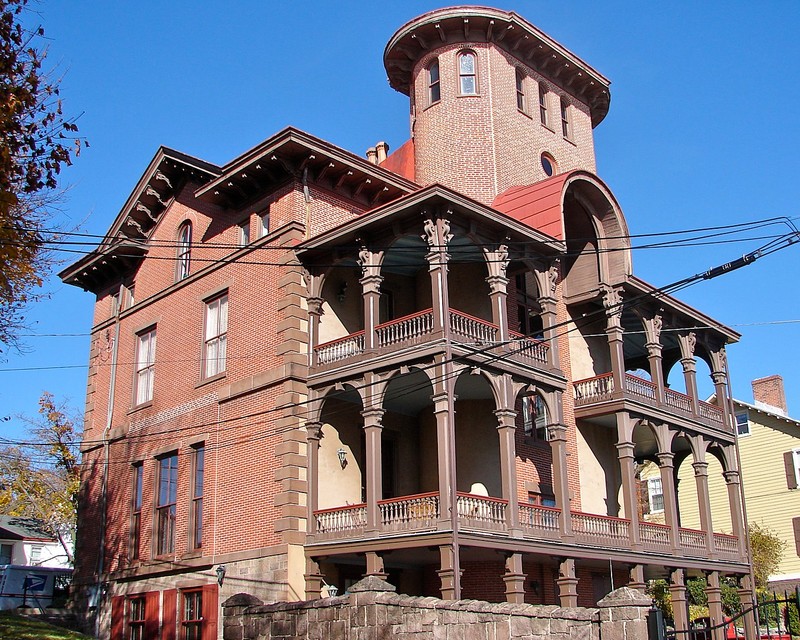Dorrance Mansion
Introduction
Text-to-speech Audio
Images
Dorrance Mansion in Bristol, PA

Backstory and Context
Text-to-speech Audio
The Italianate-designed Dorrance Mansion (circa 1863) is associated with John Dorrance, Sr., an influential Bristol resident from his arrival in 1827 to his death in 1869. He proved to be one of the first industrialists in the area to erect a mansion along the riverfront (notably Radcliffe Street), although many more followed. Still, the Dorrance mansion stood out as one of the only Italiante homes. Dorrance owned Briston Mills, worked with numerous improvement-oriented companies, and was involved in Bristol politics. His son, Arthur, proved integral to the growth of the Campbell's Soup Company. Under Dorrance's leadership, the company introduced condensed soup -- invented by his nephew, John Thompson Dorrance, which led to the company's explosive growth.
John Dorrance, Sr. arrived in Bristol during the 1820s and purchased his first home in 1828. He purchased the home shortly after he purchased an interest in Bristol Mills, a mill that started in 1701. Prior to the Civil War, the mill supplied substantial quantities of cornmeal to the American South and West Indies. He eventually bought out his partners to become the sole owner of Briston Mills. By the time of the Civil War, the mill had transitioned to a site comprised of sawmills and grist, a lumber yard, stables, coal sheds, Blacksmith shops, and various other trades. Meanwhile, he also served as the director of the Bristol Building Association (the second building and loan association organized in Pennsylvania) from 1847-1859. In addition to his attachment to the mill, Dorrance proved highly active in community improvement projects including the digging of the Bristol portion of the Delaware Division of the Pennsylvania Canal and the construction of the Trenton and Bristol Railroad in 1834. Furthermore, he served as a member of the Borough Council for nine terms between 1835 and 1860.
Although he kept his first Bristol home for his entire life, he acquired the lot across the street in 1860, with construction on the mansion occurring in 1862-1863; he only lived in the home for six years before he passed away. After Dorrance died in 1869, his sons took ownership of the mansion and the mill, although they ultimately decided to sell the mill. John Dorrance, Jr . purchased his brother's interest in 1879 and bequeathed the Mansion to his son (Dorrance's grandson) G. Morris Dorrance. All told, the mansion remained with the Dorrance family until 1921. Shortly thereafter, the Bristol Knights of Columbus purchased the home and kept it for sixty years. In 1982, the home again became a private residence.
Dorrance's other son, Arthur, became an initial investor and manager of the Campbell Soup Company. He hired his nephew, John Thompson Dorrance, who developed the company's condensed soup line that led to its expansive growth. Arther eventually took full ownership of Campell's Soup (in 1915). John Thompson Dorrance's grandson, John Dorrance III, sold his share of the company in 1996 and, according to Forbes, is worth more than $2.6 billion in 2021. Meanwhile, the Dorrance family members still represent the largest shareholders at the company.
Although Dorrance built the house toward the end of his successful career, having lived there six years before his death, it speaks to the success he gained during the mid-nineteenth century as well as the impact he had on Bristol. Additionally, the mansion stands as a reminder of the many wealthy residents who built grand homes near the Dorrance Mansion. Finally, the home is a reminder of the wealth and influence attached to the Dorrance family, demonstrated further by the success realized by his son (Arthur) and great Nephew (John Thompson) at the Campbell's Soup company.
Cite This Entry
Powers, Mathew. "Dorrance Mansion." Clio: Your Guide to History. March 1, 2021. Accessed April 23, 2025. https://theclio.com/entry/127696
Sources
"#804 John Dorrance, III." Forbes Magazine. Accessed March 1, 2021. https://www.forbes.com/profile/john-dorrance-iii/?sh=43b9bc806807
Cook, Kathleen K. "Nomination Form: Dorrace Mansion." National Register of Historic Places. archives.gov. October 16, 1986. https://catalog.archives.gov/id/71994765.
Powers, Mathew. "Arthur Dorrance House." Clio: Your Guide to History. February 12, 2021. Accessed February 28, 2021. https://www.theclio.com/entry/126634.
By Smallbones - Own work, Public Domain, https://commons.wikimedia.org/w/index.php?curid=12046194

